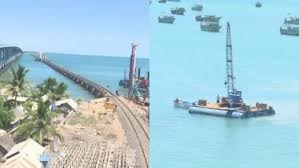Piyush Goyal-led Indian Railways has started constructing the first pillar in the sea for India’s first vertical lift railway sea bridge. The development work on the vertical lift railway sea bridge is currently going on at Pamban in the state of Tamil Nadu’s Ramanathapuram district. Earlier, it was reported that the development work on this Indian Railways’ new Pamban railway bridge was started on 8 November 2019. The overall construction work on this bridge is likely to be completed within the next two years.
This new Pamban railway sea bridge is a first-of-its-kind project for Indian Railways. The new Pamban railway sea bridge would be 2.05 kilometres long and it will link Mandapam on the mainland and Rameswaram at the Pamban island. Interestingly, it will have the nation’s first vertical launch rail section.
The vertical lift railway sea bridge project is being developed by Railway Vikas Nigam Limited. The foundation stone for the new Pamban railway sea bridge was laid by Prime Minister Narendra Modi in the month of March, last year, in Kanyakumari. The railway sea bridge is expected to help the national transporter operate trains at a higher speed, and also allow trains to carry more weight on the route. The new railway sea bridge will also maximize the traffic volume between the mainland of Pamban and Rameswaram, which is well known for its religious significance.
For the development of the new Pamban sea bridge, an amount of Rs 250 crore is being spent. The original Pamban railway bridge was commissioned in the year 1914 to connect Mandapam to the Rameswaram island situated in the Gulf of Mannar. Till the year 1988, it was the only surface link providing connectivity between the two locations, until a new road bridge was built parallel to the link. The bridge had flaps that would open to allow for movement of ferries. However, the old Pamban bridge is not suitable to speed upgradation and Indian Railways has now decided to build a fresh bridge that will have a vertical shaft to allow for ferries to pass under when trains are not operating.

